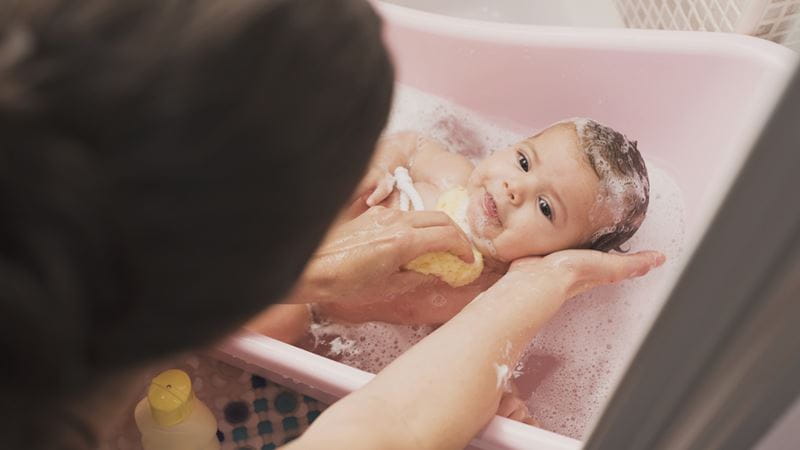Blog article
The complete guide to feeding your newborn baby

Feeding your baby is one of the most personal and important parts of early parenting – and it can come with a lot of questions.
In this blog, we’ll walk through everything from colostrum and breast pumps to bottle warmers and breastfeeding gear – with practical tips and trusted advice to help you feel confident, whatever feeding looks like in your home (whether that’s a sleepy 3am feed or a bottle warmed with military precision).
Is breastfeeding really best?
You’ve probably heard the phrase “breast is best” – and it’s true that breastfeeding offers a wide range of benefits. Breastmilk is uniquely tailored to your baby’s needs. It changes over time to support their growth, immunity, and development, and it’s packed with anti-infective properties that help protect against illness.1,2
Breastfeeding also supports bonding, is cost-effective, and offers health benefits for parents too – like the potential to reduce the risk of certain cancers and helping the uterus return to its pre-pregnancy state.1,2
But here’s the most important thing: what’s best is that your baby is fed, loved, and thriving – however that looks for your family. Feeding is a learned skill and it’s important that parents are encouraged to seek support, not pressure.1
With that out of the way – let’s get into the nitty gritty!
Check out our blog: 8 HBF parents on what helped most with breastfeeding
What is colostrum?
Colostrum is your baby’s first milk. It’s a thick, yellowish fluid packed with protein and antibodies that help protect your baby against illness. It’s produced in small amounts, but it’s perfectly suited to your newborn’s tiny tummy.1,3
When should I start expressing colostrum?
Some parents may be advised to begin expressing colostrum during the third trimester. Because each situation is unique, it’s important to follow individual medical advice.4 Colostrum can be expressed by hand or with a breast pump and stored in sterile containers for later use. (More on that later!)
Why does my baby cry when feeding?
As you’ve probably figured out by now, feeding time isn’t always smooth sailing. It’s completely normal for babies to cry during or after a feed. Crying can be your baby’s way of communicating discomfort, frustration, or a need for something different.
Here are some common reasons why your baby might cry while feeding:5,6
- Swallowing air: Babies often swallow air while feeding, especially if they’re feeding quickly or not latched properly. This can lead to wind or bloating, which may cause discomfort and fussiness.
- Need to burp: Some babies need to be burped midway through a feed or right after. If they’re unsettled, try pausing to burp them gently using upright positions like over-the-shoulder or sitting on your lap.
- Fast milk flow: If you're breastfeeding and have a strong let-down reflex (rapid release of milk), your baby might struggle to keep up with the flow. Slowing things down or expressing a little milk before feeding can help.
- Bottle feeding issues: If bottle feeding, check the teat flow. A fast-flow teat can overwhelm your baby, while a slow-flow one might frustrate them. Also, ensure the milk is at a comfortable temperature.
How to tell if my baby is still hungry after feeding
Babies are excellent communicators – even without words. Signs your baby might still be hungry after a feed include:1,3,5,6,7,8
- Active feeding cues: If your baby is still rooting (turning their head toward your breast or bottle), sucking on their hands, or fussing shortly after a feed, they may want more.
- Short or distracted feeds: If your baby only fed briefly or seemed distracted, they might not have had enough. Try offering the breast or bottle again.
- Tense body language: A full baby will usually have relaxed hands and limbs, and may turn away from the breast or bottle. If they remain tense or alert, they might still be hungry.
What if my baby won’t burp after feeding?
Burping isn’t always necessary, but many babies benefit from a pause during feeds. Try holding them upright and gently patting their back. If they seem uncomfortable or unsettled, a warm bath or tummy massage may help.5
Hand expressing vs. pumping
Both hand expressing and pumping are effective ways to collect breast milk. The best choice depends on your needs, comfort, and routine.
Hand expressing is a simple, cost-free method that can be especially helpful in the early days when your breasts feel full or your baby is having trouble latching. It’s also a great way to stimulate milk flow and relieve engorgement.
A few handy (pun intended) tips:9
- Wash your hands and find a quiet, comfortable space.
- Massage your breast gently, working toward the nipple.
- Place your thumb and forefinger in a “C” shape about 2cm behind the nipple.
- Gently press inward and squeeze to encourage milk flow.
- Rotate your fingers around the breast to empty all ducts
Hand expressing can take a little practice, but many parents find it empowering and effective, especially when expressing small amounts like colostrum.
Pumps, on the other hand, come in two main types: manual and electric. Manual pumps are great for occasional use, while electric pumps are ideal for regular expressing or if you’re returning to work.
Tips for using a pump:9
- Start with low suction and increase gradually.
- Pump until your breast feels softer or milk flow stops (usually 10–15 minutes).
- You can pump one breast while your baby feeds from the other to save time
Tips and tools for effective and safe bottle feeding
Whether you’re using expressed breast milk, infant formula, or a combination of both, bottle feeding can be a safe, practical, and nurturing way to feed your baby. Here are some helpful tools and tips to support your feeding routine:6
1. Choosing a bottle
- All bottles sold in Australia meet strict safety standards.
- Some babies prefer certain shapes or teats, so it may take a little trial and error to find the right fit.
2. A supportive baby feeding chair
- A comfortable chair with good back support can make feeding more relaxing for both you and your baby.
- While not essential, a bottle warmer can help heat milk evenly and avoid hot spots.
- Always test the temperature before feeding to ensure it’s just warm, not hot.
3. Baby bottle warmer
- While not essential, a bottle warmer can help heat milk evenly and avoid hot spots.
- Always test the temperature before feeding to ensure it’s just warm, not hot.
4. Baby bottle washer or brush
- A dedicated bottle brush helps clean all parts of the bottle thoroughly, especially the teat and screw cap
5. Cleaning and sterilising
- Milk is the perfect medium for bacteria, so it’s important to clean and sterilise bottles and teats until your baby is 12 months old.
- You can sterilise using:
- Boiling: Submerge all parts in boiling water for 5 minutes.
- Steam: Use an electric or microwave steam steriliser.
- Chemical: Use sterilising tablets or liquid as directed, and change the solution daily
How to safely store your breast milk
To keep you and your baby safe and healthy, it’s important to store expressed breast milk in clean, sterilised containers. Here’s a quick guide:1,9
- Room temp (up to 26°C): 6–8 hours
- Fridge (≤5°C): Up to 72 hours
- Freezer (–18°C): 3 months
- Deep freeze (–20°C): 6–12 months
Always label containers with the date and time and never refreeze thawed milk. If your baby starts a feed, discard any leftover milk.
Breastfeeding gear to make life easier
Breastfeeding can be a beautiful bonding experience, but it also comes with its challenges. The right gear can make feeding more comfortable, practical, and manageable – especially in those early weeks. Here are a few essentials that can help:
Nipple shield: A nipple shield is a soft, flexible silicone cover that fits over your nipple during breastfeeding. It can help with attachment issues, flat or inverted nipples and may also assist babies who have trouble latching. It’s best to use nipple shields under the guidance of a lactation consultant.14
Breastfeeding pillow: A specially shaped pillow that supports your baby’s body and helps position them at breast height, it can help to reduce strain on your arms, shoulders, and back.
Breastfeeding jumper: A jumper designed with discreet openings or zippers for easy access during feeds.
Breastfeeding top: These tops feature built-in panels or layers that allow quick and discreet access to the breast.
Foods to avoid when breastfeeding
There’s no need to follow a strict or special diet while breastfeeding – but nourishing your body with a variety of healthy foods and staying hydrated can help support your energy levels and milk production. What you eat can also influence the quality of your breastmilk and your overall wellbeing.
Things to limit or avoid include:
- Alcohol: The National Health and Medical Research Council (NHMRC) recommends that breastfeeding mothers avoid alcohol.10
- Smoking: Smoking can reduce milk supply and interfere with the let-down reflex.11
- Caffeine: Moderate caffeine intake generally considered safe, but too much may affect your baby’s sleep or make them unsettled.12
Most medications are safe to take while breastfeeding but always check with your GP or pharmacist.13
Where to go for help
Feeding can be emotional, exhausting, and sometimes downright confusing, but it’s important to remember you’re not alone. If you need help, speak to your GP, child health nurse, or book in for a consult with a lactation specialist.
You can also call the Australian Breastfeeding Association hotline on 1800 686 268 (1800 mum 2 mum).
For extra support, you can call Pregnancy, Birth and Baby, a national Australian Government service, on 1800 882 436 or use their video call service to speak directly with a maternal child health nurse. This free service is available 7 days a week, from 7am to midnight (AET). You can also call the Healthdirect helpline on 1800 022 222, available 24/7.


